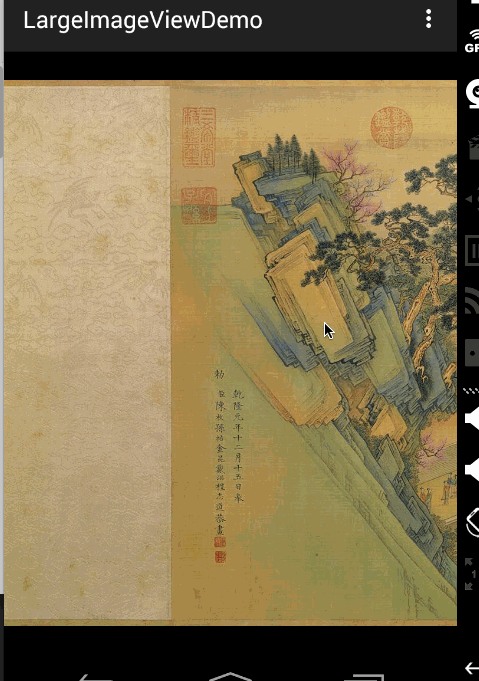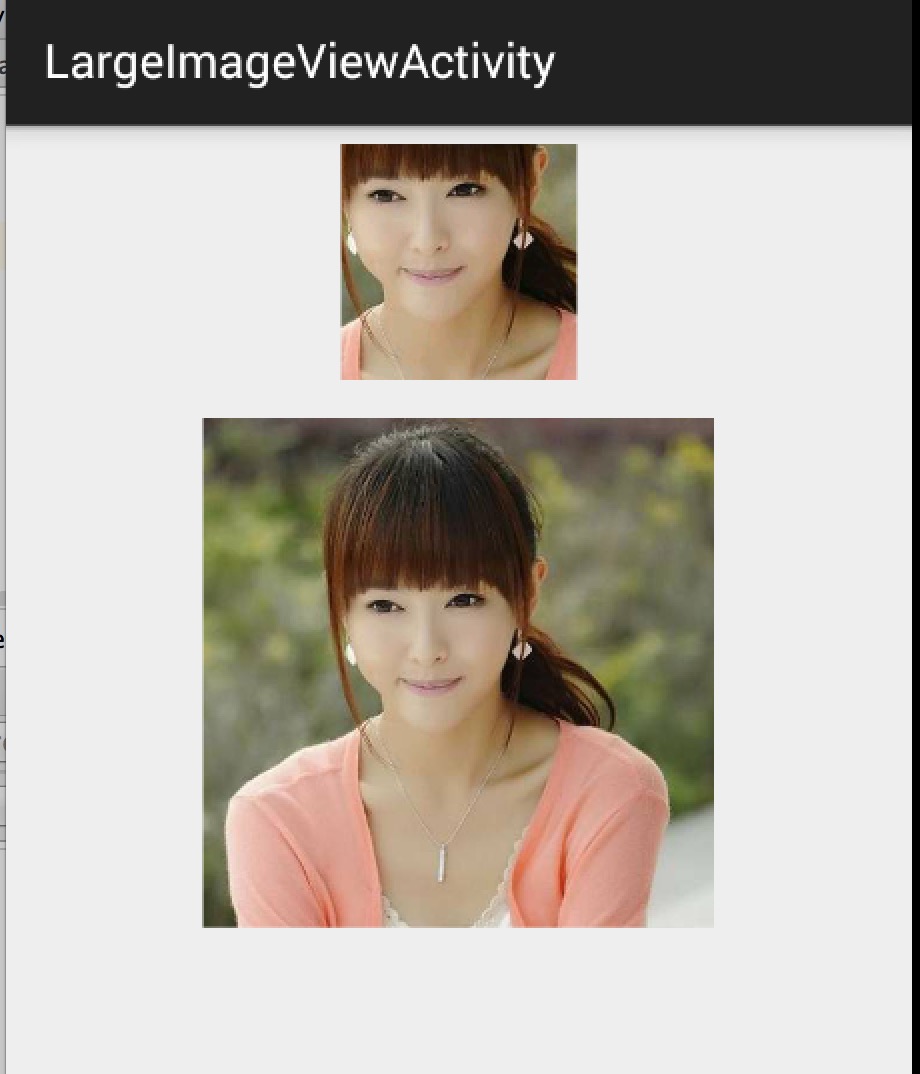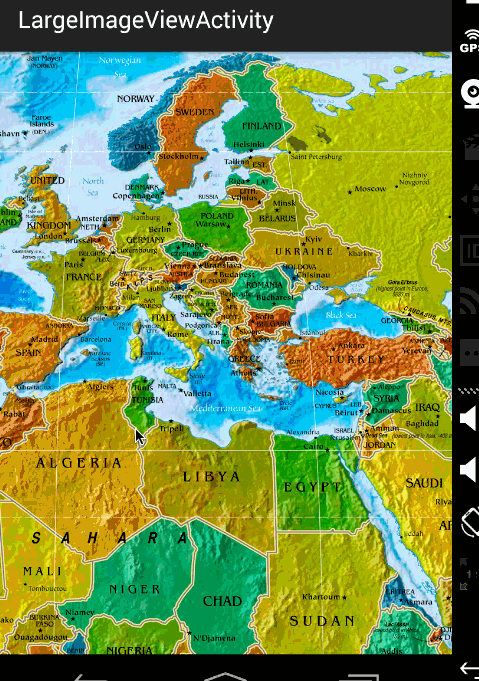Android 高清載入巨圖方案 拒絕壓縮圖片
Android 高清載入巨圖方案 拒絕壓縮圖片
轉載請標明出處:
http://blog.csdn.net/lmj623565791/article/details/49300989;
本文出自:【張鴻洋的部落格】
一、概述
距離上一篇部落格有段時間沒更新了,主要是最近有些私事導致的,那麼就先來一篇簡單一點的部落格脈動回來。
對於載入圖片,大家都不陌生,一般為了儘可能避免OOM都會按照如下做法:
- 對於圖片顯示:根據需要顯示圖片控制元件的大小對圖片進行壓縮顯示。
- 如果圖片數量非常多:則會使用LruCache等快取機制,將所有圖片佔據的內容維持在一個範圍內。
其實對於圖片載入還有種情況,就是單個圖片非常巨大,並且還不允許壓縮。比如顯示:世界地圖、清明上河圖、微博長圖等。
那麼對於這種需求,該如何做呢?
首先不壓縮,按照原圖尺寸載入,那麼螢幕肯定是不夠大的,並且考慮到記憶體的情況,不可能一次性整圖載入到記憶體中,所以肯定是區域性載入,那麼就需要用到一個類:
BitmapRegionDecoder
其次,既然螢幕顯示不完,那麼最起碼要新增一個上下左右拖動的手勢,讓使用者可以拖動檢視。
那麼綜上,本篇博文的目的就是去自定義一個顯示巨圖的View,支援使用者去拖動檢視,大概的效果圖如下:
好吧,這清明上河圖太長了,想要觀看全圖,文末下載,圖片在assets目錄。當然如果你的圖,高度也很大,肯定也是可以上下拖動的。
二、初識BitmapRegionDecoder
BitmapRegionDecoder主要用於顯示圖片的某一塊矩形區域,如果你需要顯示某個圖片的指定區域,那麼這個類非常合適。
對於該類的用法,非常簡單,既然是顯示圖片的某一塊區域,那麼至少只需要一個方法去設定圖片;一個方法傳入顯示的區域即可;詳見:
BitmapRegionDecoder提供了一系列的newInstance方法來構造物件,支援傳入檔案路徑,檔案描述符,檔案的inputstrem等。
例如:
BitmapRegionDecoder bitmapRegionDecoder = BitmapRegionDecoder.newInstance(inputStream, false);上述解決了傳入我們需要處理的圖片,那麼接下來就是顯示指定的區域。
bitmapRegionDecoder.decodeRegion(rect, options);引數一很明顯是一個rect,引數二是BitmapFactory.Options,你可以控制圖片的
inSampleSize,inPreferredConfig等。
那麼下面看一個超級簡單的例子:
package com.zhy.blogcodes.largeImage;
import android.graphics.Bitmap;
import android.graphics.BitmapFactory;
import android.graphics.BitmapRegionDecoder;
import android.graphics.Rect;
import android.os.Bundle;
import android.support.v7.app.AppCompatActivity;
import android.widget.ImageView;
import com.zhy.blogcodes.R;
import java.io.IOException;
import java.io.InputStream;
public class LargeImageViewActivity extends AppCompatActivity
{
private ImageView mImageView;
@Override
protected void onCreate(Bundle savedInstanceState)
{
super.onCreate(savedInstanceState);
setContentView(R.layout.activity_large_image_view);
mImageView = (ImageView) findViewById(R.id.id_imageview);
try
{
InputStream inputStream = getAssets().open("tangyan.jpg");
//獲得圖片的寬、高
BitmapFactory.Options tmpOptions = new BitmapFactory.Options();
tmpOptions.inJustDecodeBounds = true;
BitmapFactory.decodeStream(inputStream, null, tmpOptions);
int width = tmpOptions.outWidth;
int height = tmpOptions.outHeight;
//設定顯示圖片的中心區域
BitmapRegionDecoder bitmapRegionDecoder = BitmapRegionDecoder.newInstance(inputStream, false);
BitmapFactory.Options options = new BitmapFactory.Options();
options.inPreferredConfig = Bitmap.Config.RGB_565;
Bitmap bitmap = bitmapRegionDecoder.decodeRegion(new Rect(width / 2 - 100, height / 2 - 100, width / 2 + 100, height / 2 + 100), options);
mImageView.setImageBitmap(bitmap);
} catch (IOException e)
{
e.printStackTrace();
}
}
}
上述程式碼,就是使用BitmapRegionDecoder去載入assets中的圖片,呼叫bitmapRegionDecoder.decodeRegion解析圖片的中間矩形區域,返回bitmap,最終顯示在ImageView上。
效果圖:
上面的小圖顯示的即為下面的大圖的中間區域。
ok,那麼目前我們已經瞭解了BitmapRegionDecoder的基本使用者,那麼往外擴散,我們需要自定義一個控制元件去顯示巨圖就很簡單了,首先Rect的範圍就是我們View的大小,然後根據使用者的移動手勢,不斷去更新我們的Rect的引數即可。
三、自定義顯示大圖控制元件
根據上面的分析呢,我們這個自定義控制元件思路就非常清晰了:
- 提供一個設定圖片的入口
- 重寫onTouchEvent,在裡面根據使用者移動的手勢,去更新顯示區域的引數
- 每次更新區域引數後,呼叫invalidate,onDraw裡面去regionDecoder.decodeRegion拿到bitmap,去draw
理清了,發現so easy,下面上程式碼:
package com.zhy.blogcodes.largeImage.view;
import android.content.Context;
import android.graphics.Bitmap;
import android.graphics.BitmapFactory;
import android.graphics.BitmapRegionDecoder;
import android.graphics.Canvas;
import android.graphics.Rect;
import android.util.AttributeSet;
import android.view.MotionEvent;
import android.view.View;
import java.io.IOException;
import java.io.InputStream;
/**
* Created by zhy on 15/5/16.
*/
public class LargeImageView extends View
{
private BitmapRegionDecoder mDecoder;
/**
* 圖片的寬度和高度
*/
private int mImageWidth, mImageHeight;
/**
* 繪製的區域
*/
private volatile Rect mRect = new Rect();
private MoveGestureDetector mDetector;
private static final BitmapFactory.Options options = new BitmapFactory.Options();
static
{
options.inPreferredConfig = Bitmap.Config.RGB_565;
}
public void setInputStream(InputStream is)
{
try
{
mDecoder = BitmapRegionDecoder.newInstance(is, false);
BitmapFactory.Options tmpOptions = new BitmapFactory.Options();
// Grab the bounds for the scene dimensions
tmpOptions.inJustDecodeBounds = true;
BitmapFactory.decodeStream(is, null, tmpOptions);
mImageWidth = tmpOptions.outWidth;
mImageHeight = tmpOptions.outHeight;
requestLayout();
invalidate();
} catch (IOException e)
{
e.printStackTrace();
} finally
{
try
{
if (is != null) is.close();
} catch (Exception e)
{
}
}
}
public void init()
{
mDetector = new MoveGestureDetector(getContext(), new MoveGestureDetector.SimpleMoveGestureDetector()
{
@Override
public boolean onMove(MoveGestureDetector detector)
{
int moveX = (int) detector.getMoveX();
int moveY = (int) detector.getMoveY();
if (mImageWidth > getWidth())
{
mRect.offset(-moveX, 0);
checkWidth();
invalidate();
}
if (mImageHeight > getHeight())
{
mRect.offset(0, -moveY);
checkHeight();
invalidate();
}
return true;
}
});
}
private void checkWidth()
{
Rect rect = mRect;
int imageWidth = mImageWidth;
int imageHeight = mImageHeight;
if (rect.right > imageWidth)
{
rect.right = imageWidth;
rect.left = imageWidth - getWidth();
}
if (rect.left < 0)
{
rect.left = 0;
rect.right = getWidth();
}
}
private void checkHeight()
{
Rect rect = mRect;
int imageWidth = mImageWidth;
int imageHeight = mImageHeight;
if (rect.bottom > imageHeight)
{
rect.bottom = imageHeight;
rect.top = imageHeight - getHeight();
}
if (rect.top < 0)
{
rect.top = 0;
rect.bottom = getHeight();
}
}
public LargeImageView(Context context, AttributeSet attrs)
{
super(context, attrs);
init();
}
@Override
public boolean onTouchEvent(MotionEvent event)
{
mDetector.onToucEvent(event);
return true;
}
@Override
protected void onDraw(Canvas canvas)
{
Bitmap bm = mDecoder.decodeRegion(mRect, options);
canvas.drawBitmap(bm, 0, 0, null);
}
@Override
protected void onMeasure(int widthMeasureSpec, int heightMeasureSpec)
{
super.onMeasure(widthMeasureSpec, heightMeasureSpec);
int width = getMeasuredWidth();
int height = getMeasuredHeight();
int imageWidth = mImageWidth;
int imageHeight = mImageHeight;
//預設直接顯示圖片的中心區域,可以自己去調節
mRect.left = imageWidth / 2 - width / 2;
mRect.top = imageHeight / 2 - height / 2;
mRect.right = mRect.left + width;
mRect.bottom = mRect.top + height;
}
}
根據上述原始碼:
- setInputStream裡面去獲得圖片的真實的寬度和高度,以及初始化我們的mDecoder
- onMeasure裡面為我們的顯示區域的rect賦值,大小為view的尺寸
- onTouchEvent裡面我們監聽move的手勢,在監聽的回撥裡面去改變rect的引數,以及做邊界檢查,最後invalidate
- 在onDraw裡面就是根據rect拿到bitmap,然後draw了
ok,上面並不複雜,不過大家有沒有注意到,這個監聽使用者move手勢的程式碼寫的有點奇怪,恩,這裡模仿了系統的ScaleGestureDetector,編寫了MoveGestureDetector,程式碼如下:
MoveGestureDetector
package com.zhy.blogcodes.largeImage.view; import android.content.Context; import android.graphics.PointF; import android.view.MotionEvent; public class MoveGestureDetector extends BaseGestureDetector { private PointF mCurrentPointer; private PointF mPrePointer; //僅僅為了減少建立記憶體 private PointF mDeltaPointer = new PointF(); //用於記錄最終結果,並返回 private PointF mExtenalPointer = new PointF(); private OnMoveGestureListener mListenter; public MoveGestureDetector(Context context, OnMoveGestureListener listener) { super(context); mListenter = listener; } @Override protected void handleInProgressEvent(MotionEvent event) { int actionCode = event.getAction() & MotionEvent.ACTION_MASK; switch (actionCode) { case MotionEvent.ACTION_CANCEL: case MotionEvent.ACTION_UP: mListenter.onMoveEnd(this); resetState(); break; case MotionEvent.ACTION_MOVE: updateStateByEvent(event); boolean update = mListenter.onMove(this); if (update) { mPreMotionEvent.recycle(); mPreMotionEvent = MotionEvent.obtain(event); } break; } } @Override protected void handleStartProgressEvent(MotionEvent event) { int actionCode = event.getAction() & MotionEvent.ACTION_MASK; switch (actionCode) { case MotionEvent.ACTION_DOWN: resetState();//防止沒有接收到CANCEL or UP ,保險起見 mPreMotionEvent = MotionEvent.obtain(event); updateStateByEvent(event); break; case MotionEvent.ACTION_MOVE: mGestureInProgress = mListenter.onMoveBegin(this); break; } } protected void updateStateByEvent(MotionEvent event) { final MotionEvent prev = mPreMotionEvent; mPrePointer = caculateFocalPointer(prev); mCurrentPointer = caculateFocalPointer(event); //Log.e("TAG", mPrePointer.toString() + " , " + mCurrentPointer); boolean mSkipThisMoveEvent = prev.getPointerCount() != event.getPointerCount(); //Log.e("TAG", "mSkipThisMoveEvent = " + mSkipThisMoveEvent); mExtenalPointer.x = mSkipThisMoveEvent ? 0 : mCurrentPointer.x - mPrePointer.x; mExtenalPointer.y = mSkipThisMoveEvent ? 0 : mCurrentPointer.y - mPrePointer.y; } /** * 根據event計算多指中心點 * * @param event * @return */ private PointF caculateFocalPointer(MotionEvent event) { final int count = event.getPointerCount(); float x = 0, y = 0; for (int i = 0; i < count; i++) { x += event.getX(i); y += event.getY(i); } x /= count; y /= count; return new PointF(x, y); } public float getMoveX() { return mExtenalPointer.x; } public float getMoveY() { return mExtenalPointer.y; } public interface OnMoveGestureListener { public boolean onMoveBegin(MoveGestureDetector detector); public boolean onMove(MoveGestureDetector detector); public void onMoveEnd(MoveGestureDetector detector); } public static class SimpleMoveGestureDetector implements OnMoveGestureListener { @Override public boolean onMoveBegin(MoveGestureDetector detector) { return true; } @Override public boolean onMove(MoveGestureDetector detector) { return false; } @Override public void onMoveEnd(MoveGestureDetector detector) { } } }BaseGestureDetector
package com.zhy.blogcodes.largeImage.view; import android.content.Context; import android.view.MotionEvent; public abstract class BaseGestureDetector { protected boolean mGestureInProgress; protected MotionEvent mPreMotionEvent; protected MotionEvent mCurrentMotionEvent; protected Context mContext; public BaseGestureDetector(Context context) { mContext = context; } public boolean onToucEvent(MotionEvent event) { if (!mGestureInProgress) { handleStartProgressEvent(event); } else { handleInProgressEvent(event); } return true; } protected abstract void handleInProgressEvent(MotionEvent event); protected abstract void handleStartProgressEvent(MotionEvent event); protected abstract void updateStateByEvent(MotionEvent event); protected void resetState() { if (mPreMotionEvent != null) { mPreMotionEvent.recycle(); mPreMotionEvent = null; } if (mCurrentMotionEvent != null) { mCurrentMotionEvent.recycle(); mCurrentMotionEvent = null; } mGestureInProgress = false; } }你可能會說,一個move手勢搞這麼多程式碼,太麻煩了。的確是的,move手勢的檢測非常簡單,那麼之所以這麼寫呢,主要是為了可以複用,比如現在有一堆的
XXXGestureDetector,當我們需要監聽什麼手勢,就直接拿個detector來檢測多方便。我相信大家肯定也鬱悶過Google,為什麼只有ScaleGestureDetector而沒有RotateGestureDetector呢。
根據上述,大家應該理解了為什麼要這麼做,當時不強制,每個人都有個性。
不過值得一提的是:上面這個手勢檢測的寫法,不是我想的,而是一個開源的專案https://github.com/rharter/android-gesture-detectors,裡面包含很多的手勢檢測。對應的博文是:http://code.almeros.com/android-multitouch-gesture-detectors#.VibzzhArJXg那面上面兩個類就是我偷學了的~ 哈
四、測試
測試其實沒撒好說的了,就是把我們的LargeImageView放入佈局檔案,然後Activity裡面去設定inputstream了。
<RelativeLayout xmlns:android="http://schemas.android.com/apk/res/android"
xmlns:tools="http://schemas.android.com/tools"
android:layout_width="match_parent"
android:layout_height="match_parent">
<com.zhy.blogcodes.largeImage.view.LargeImageView
android:id="@+id/id_largetImageview"
android:layout_width="match_parent"
android:layout_height="match_parent"/>
</RelativeLayout>然後在Activity裡面去設定圖片:
package com.zhy.blogcodes.largeImage;
import android.os.Bundle;
import android.support.v7.app.AppCompatActivity;
import com.zhy.blogcodes.R;
import com.zhy.blogcodes.largeImage.view.LargeImageView;
import java.io.IOException;
import java.io.InputStream;
public class LargeImageViewActivity extends AppCompatActivity
{
private LargeImageView mLargeImageView;
@Override
protected void onCreate(Bundle savedInstanceState)
{
super.onCreate(savedInstanceState);
setContentView(R.layout.activity_large_image_view);
mLargeImageView = (LargeImageView) findViewById(R.id.id_largetImageview);
try
{
InputStream inputStream = getAssets().open("world.jpg");
mLargeImageView.setInputStream(inputStream);
} catch (IOException e)
{
e.printStackTrace();
}
}
}效果圖:
ok,那麼到此,顯示巨圖的方案以及詳細的程式碼就描述完成了,總體還是非常簡單的。
但是,在實際的專案中,可能會有更多的需求,比如增加放大、縮小;增加快滑手勢等等,那麼大家可以去參考這個庫:https://github.com/johnnylambada/WorldMap,該庫基本實現了絕大多數的需求,大家根據本文這個思路再去看這個庫,也會簡單很多,定製起來也容易。我這個地圖的圖就是該庫裡面提供的。
哈,掌握了這個,以後面試過程中也可以悄悄的裝一把了,當你優雅的答完android載入圖片的方案以後,然後接一句,其實還有一種情況,就是高清顯示巨圖,那麼我們應該…相信面試官對你的印象會好很多~ have a nice day ~
歡迎關注我的微博:
http://weibo.com/u/3165018720
群號:463081660,歡迎入群
微信公眾號:hongyangAndroid
(歡迎關注,第一時間推送博文資訊)
參考連結
相關文章
- Android 載入大圖片,不壓縮圖片Android
- 前端圖片壓縮方案前端
- android下圖片壓縮Android
- Android壓縮圖片後再上傳圖片Android
- 前端圖片壓縮 - H5&Uni-App圖片壓縮前端H5APP
- Android 中圖片壓縮分析(上)Android
- ??圖片壓縮CanvasCanvas
- IOS圖片壓縮iOS
- canvas 壓縮圖片Canvas
- android圖片壓縮不失真實戰Android
- 圖片壓縮知識梳理(0) 圖片壓縮學習計劃
- Android微信分享圖片按質量壓縮的解決方案Android
- iOS 圖片壓縮方法iOS
- 前端的圖片壓縮image-compressor(可在圖片上傳前實現圖片壓縮)前端
- 【前端】壓縮圖片以及圖片相關概念前端
- vue 上傳圖片進行壓縮圖片Vue
- Nginx網路壓縮 CSS壓縮 圖片壓縮 JSON壓縮NginxCSSJSON
- Android-壓縮大圖到容量超小的圖片Android
- Android-圖片壓縮(二)-純乾貨Android
- android 比較靠譜的圖片壓縮Android
- 仿寫一個android圖片壓縮工具Android
- Android 圖片壓縮方法分析與學習Android
- SmallImage for Mac(圖片壓縮工具)Mac
- js上傳圖片壓縮JS
- js圖片壓縮推薦JS
- JNI實現圖片壓縮
- java後臺壓縮圖片Java
- AlamofireImage 使用 – swift載入網路圖片,縮放圖片,生成圓形圖片Swift
- Android 圖片載入框架Android框架
- android 載入大量圖片Android
- 怎麼轉換圖片格式並壓縮圖片
- 圖片壓縮怎樣操作?分享幾種實用的批次圖片壓縮技巧
- 淺談移動端圖片壓縮(iOS & Android)iOSAndroid
- 簡單實用的android 圖片的壓縮Android
- Android如何壓縮圖片上傳服務端Android服務端
- 載入GIF圖片優化方案優化
- 圖片壓縮不求人,3個親測實用高效的圖片壓縮神器
- Android 圖片縮放Android



